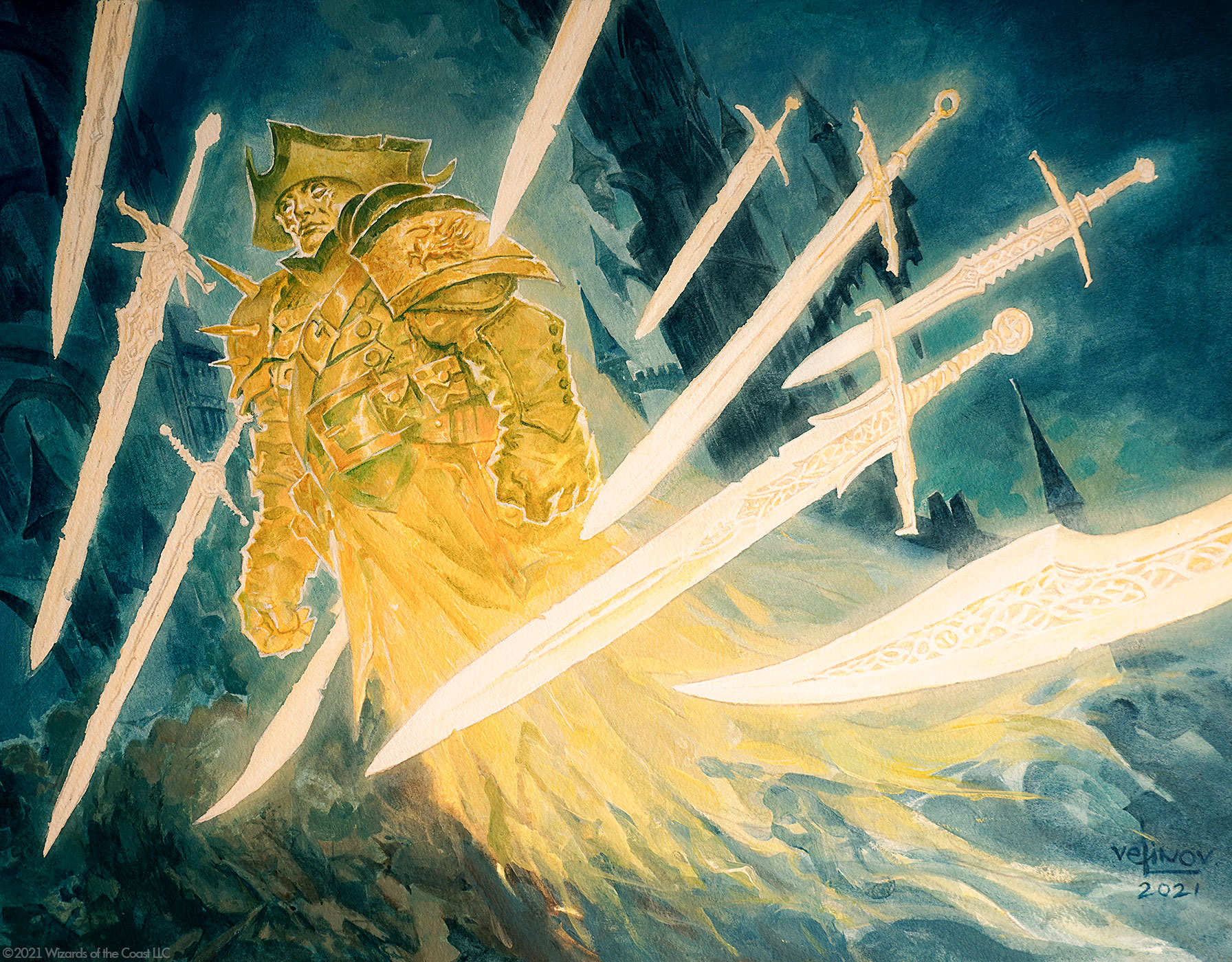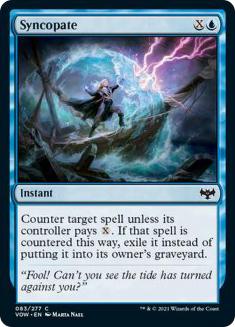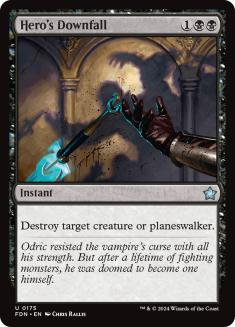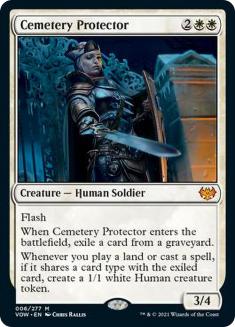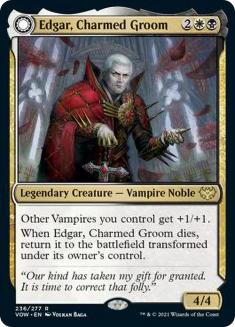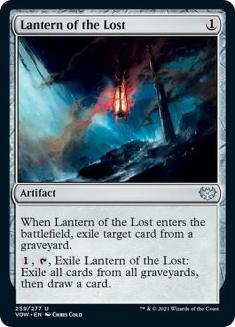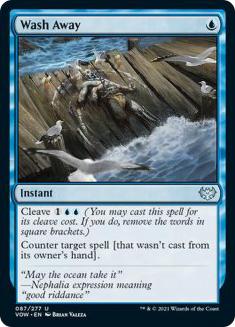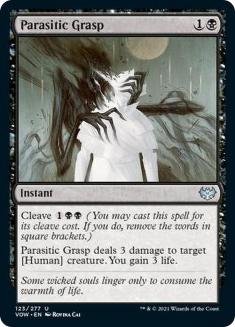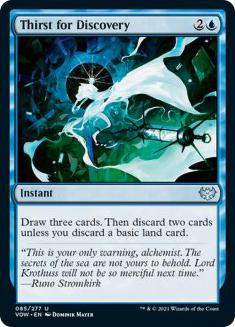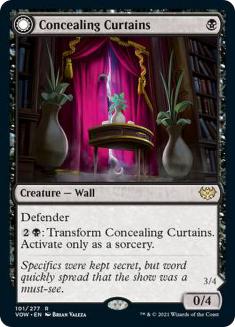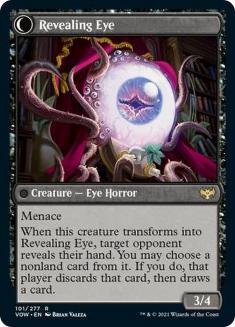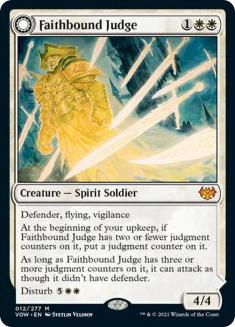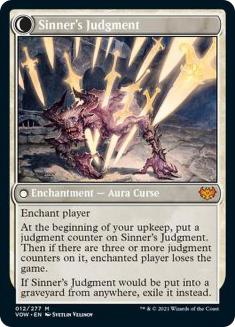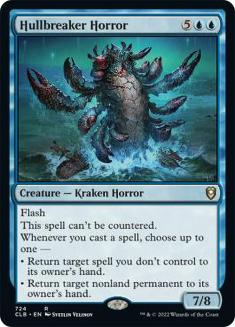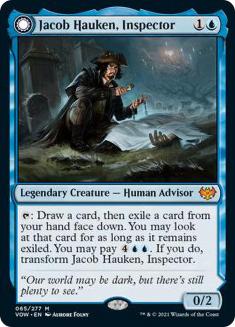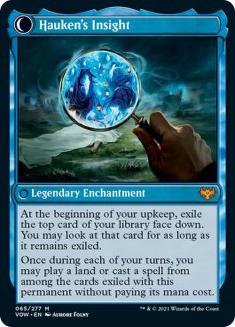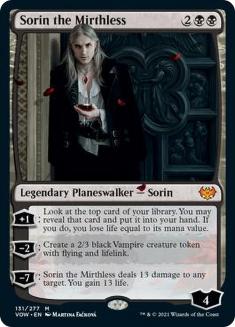Innistrad: Crimson Vow has impressed me throughout the preview season. The cards are not stronger than the current options we have in Standard, but they open many opportunities for brewers that are dying to try new things. Control has significantly increased its win condition pool to choose from with the release of Innistrad: Crimson Vow, and that alone makes me happy with a set. Not only are there more viable win conditions, but many of them also require different deckbuilding angles to get the biggest bang for their buck.
I spent a good amount of time sculpting my Top 8 list of cards that would positively impact control in Standard. Many cards that did not make the cut in the end could have if the set were a bit weaker. These honorable mentions are simply not at the level of strength that my list could potentially hit, making them fall a bit short at the end for me. It’s likely that they see some play throughout their time in Standard; however, the excitement behind them is not nearly as high as it is for my main list. These are the ones that missed out:
Many of the cards depicted above are weaker options than what exist or fall short to their Innistrad: Crimson Vow competitors. Hero’s Downfall and Syncopate were big hitters in the olden days but are a bit more mana-intensive than most of the options in the current Dimir Control deck. There’s a likelihood that my decks run one copy of Hero’s Downfall, although it is much weaker than Bloodchief’s Thirst in the current Standard metagame. Syncopate is also tough on the mana in the mid- and late-game, as well as being embarrassing with Lier, Disciple of the Drowned. All countermagic is at its low point because of the dominant blue creature, but Syncopate is worse than others here. It does not assist in pushing through a Lier like a hard counter would, nor does it scale as well as the game goes on when Lier is not present.
The other cards on this list are of sweet design but may not be practical: a couple of sweet four-drops with Edgar, Charmed Groom and Cemetery Protector, for a mage who does not enjoy employing many creatures. Each produces continued advantage, with Cemetery Protector assisting against a problematic graveyard card. Edgar, Charmed Groom is a resilient threat that produces lifelink creatures when it dies, and then it returns once three exist on the battlefield. I really like both the cards, and the recast of Relic of Progenitus, but they’re not in my top choices.
8. Wash Away
This counterspell will likely see play in all formats that heavily use foretell, cast spells from the graveyard, or rely on cascade. In Standard, foretell is one of the top mechanics, heavily used by the best deck in the format. Izzet Epiphany is bringing the pain with extra turns, but Wash Away is a viable answer to that effect.
Not only does it stop those foretell spells in their tracks, it also can be used as a three-mana hard counter when another spell needs stopping. Lier is the only hitch that prevents this card from being higher on the Top 8 chart, as it hinders the ability to use counterspells in a traditional control deck. For better or worse, Lier is the direction that control should continue to move in, even with the advancements from Innistrad: Crimson Vow. The card is too powerful to turn our backs on, so continue to table counterspells until it leaves the format.
7. Parasitic Grasp
Black-based removal is so good in Standard that any new member of the club must endure high scrutiny. There are just too many cards to employ in too few spots, but at least the Lier decks encourage diversity in the removal package. With a near-guaranteed flashback in the future, having a wide net to cast on enemy creatures is highly beneficial.
For that reason, Parasitic Grasp will see play in Standard to down a creature, preferably a Human, with a lifgain bonus at the end. It’s a reasonable spell without a Human being present; however, it will probably be a sideboard card that comes in when that creature type is a common theme across the battlefield. Other than that scenario, Mono-Red Aggro would have to make a comeback for me to consider multiple copies maindeck (or a huge resurgence of Mono-White Aggro❄ to the top tables).
6. Thirst for Discovery
Almost as competitive as black-based removal, blue card draw is at a historic high in terms of Standard strength. I never thought Memory Deluge would have to battle over the four-mana draw slot, but Behold the Multiverse has proven persistent. Many people prefer Behold the Multiverse; however, I’m not ready to make that commitment here.
With Thirst for Discovery, the conversation then moves to the amount of card draw spells permitted in a Standard control deck. I’m currently running one Consider in my Dimir Control deck, which will become one Thirst for Discovery. I wanted something early that could also add some fuel to the graveyard and this card draw spell fits the bill. It’s worse than the four-mana options we currently have, but it can serve a purpose for the turns before they’re online. If there are enough basic lands in your deck, Thirst for Discovery can bring you success, the same way Thirst for Knowledge and Compulsive Research did in the past.
5. Concealing Curtains
This has the makings of a great card for control in Standard. Concealing Curtains is a blocker in the early-game, which is relevant against two strong aggro decks. Since it’s an 0/4, it handles most threats that head its way. That one-mana investment can save a ton of life points, and then produce a powerful disruption effect for just three mana.
It transforms to a 3/4 creature with menace and attacks the opponent’s hand, forcing them to discard a card of your choice and giving them a random one off the top of their library. This has the feel of a Vendilion Clique, but with a much cooler design. I really like the way it assists in the early-game while being highly relevant in the mid- and late-game. I’m not sure if it fits in a Dimir Control (with Lier) maindeck, but its design is strong enough to open some home for it in Standard.
4. Faithbound Judge
The remaining cards on my list are all potential win conditions. Coming in at #4 is Faithbound Judge, a card that reads like some control’s player fan fiction. It has all the keywords to block creatures early on and turns into an attacker after a few turns. It only costs three mana to cast, making it a reasonable maindeck card that’s good against aggro, midrange, and control decks.
Being a blocker and a threat alone isn’t enough to earn it a spot in competitive play, but its ability to return to the battlefield after death does. For seven mana, it becomes an enchantment that wins the game if not dealt with after three upkeeps. There’s not much enchantment removal being played these days, and even if there were, it remains a drain on the opponent’s resources. Having to deal with the creature and enchantment may become a challenge for some decks, which is why Faithbound Judge is on my Top 8 list for control cards in this upcoming set.
3. Hullbreaker Horror
This blue monstrosity was higher on my list at first, due to my inherent bias. I love having a haymaker against the control mirror and Hullbreaker Horror is exactly that. This will be my out to steal the game away from enemy blue decks and edit the way I build my control decks.
Cheap instant-speed cards will enhance Hullbreaker Horror, making it nearly impossible to kill with mana open. Not only is it easy to protect, it also cannot be countered, answers most threats on the battlefield, and hits like a truck. The obvious drawback is the seven-mana price tag, one that I’ll pay gladly for the upside it brings. I envision this as a sideboard silver bullet, but there’s a strong possibility it fights alongside Lier in the maindeck as a one-of. Outside of super-fast aggro decks, Hullbreak Horror will have time to hit the battlefield before the enemy forces get too large. If it does, I would not want to be on the receiving end.
2. Jacob Hauken, Inspector
This isn’t the grand return of Jace, Vryn’s Prodigy, but it’s close enough. I love a good two-mana looter, one that can help filter out poor draws, while offering tremendous upside later in the game. Jace, Vryn’s Prodigy was an easy card to transform, but the result was a medium-powered planeswalker. Jacob Hauken, Inspector gives that early-game Jace feel and has a similar target on its head because of its low toughness.
Although Jace was tough to beat if left out, Jacob Hauken may be close to impossible to defeat once it transforms in some matchups. It produces an avalanche of advantage, with a “cast without paying its mana cost” clause that scares anyone sitting across the table. I’m always thinking of the unfair applications of my control cards and Jacob Hauken can do some very broken things, even in Standard. We’re not casting Emrakul, the Aeons Torn, but even dropping a free Hullbreaker or Lier can end the game on the spot. Even if a giant creature is not your thing, it can play lands or cast reasonable spells that were exiled by this permanent. It continues to add cards to exile each turn, making it snowball out of control very quickly. With fair or unfair options, Jacob Hauken is my second-favorite control card to come out of this set.
1. Sorin the Mirthless
The best control card in Innistrad: Crimson Vow is Sorin the Mirthless. The gap between my #1 choice and the rest is huge, as I believe Sorin is a game-changer for traditional control decks in Standard. There has been a huge deficit in the planeswalker department for quite some time now, but that drought has finally ended. Sorin is the total package, producing card advantage, premier creatures, and a game-ending ultimate.
The card advantage has a little pain attached but is optional to use. Being able to look at the card first is big, giving the user some agency while sculpting a game plan. The creature production is amazing, giving us a 2/3 flyer with lifelink, which is an upgrade from previous versions. Those two abilities on their own are enough to sell me on Sorin, but the ultimate is a nice bonus. It hits for thirteen and gains thirteen life, ending most games instantly. Sorin adds all this for only four mana and has a strong starting loyalty of four to boot. I cannot imagine playing a black-based control deck in Standard without Sorin moving forward, even in a Lier deck that requires mostly instants and sorceries.
Innistrad: Crimson Vow has big potential in Standard and I hope it can break the Izzet Epiphany stranglehold that we have seen for the last couple of months.

